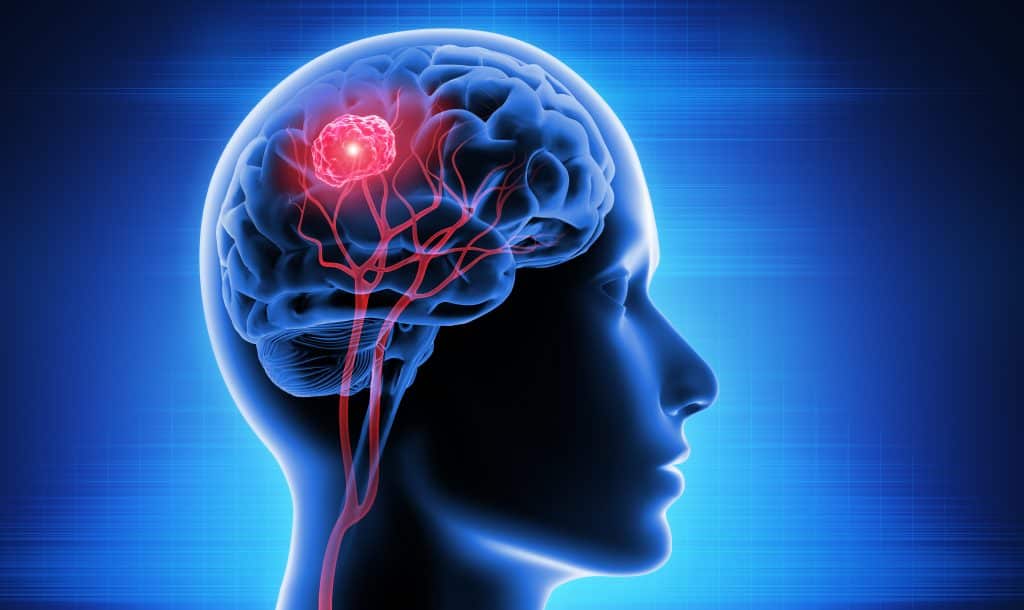A brain tumor is a collection, or mass, of abnormal cells in the brain. The skull is very rigid and leaves no room to accommodate even a benign mass. Brain tumors can be cancerous (malignant) or noncancerous (benign). When benign or malignant tumors grow, they can cause the pressure inside your skull to increase. This can cause brain damage, and it can be life-threatening.
Brain tumors are categorized as primary or secondary. A primary brain tumor originates in the brain and many primary brain tumors are benign. A secondary brain tumor, also known as a metastatic brain tumor, occurs when cancer cells spread to the brain from another organ, such as the skin, kidney, lung or breast. Secondary brain tumors make up the majority of brain cancers.
The risk for brain tumors increases with age. Only about 5-10% of all brain cancers are hereditary. Brain tumors in general are more common among Caucasians. However, African-American people are more likely to get meningiomas. People who have been exposed to ionizing radiation have an increased risk of brain tumors. Patients can be exposed to ionizing radiation through high-radiation cancer therapies. People can also be exposed to radiation from nuclear fallout. The nuclear power plant incidents in Fukushima and Chernobyl are examples of how people can be exposed to ionizing radiation.
Interestingly, according to the American Brain Tumor Association, people with a history of childhood chicken pox have a decreased risk of getting brain tumors.
Symptoms of brain tumors depend on the location and size of the tumor. Some tumors cause direct damage by invading brain tissue while some cause pressure on the surrounding brain. There will be noticeable symptoms when a growing tumor is putting pressure on brain tissue.
Headaches are a common symptom of a brain tumor. Headaches typically:
- are worse in the morning when waking up
- occur while sleeping
- are made worse by coughing, sneezing, or exercise
Other side-effects include:
- vomiting
- blurred vision or double vision
- confusion
- seizures (especially in adults)
- weakness of a limb or part of the face
- a change in mental functioning
Because the brain is responsible for everything that happens in the body, other common symptoms include:
- clumsiness
- memory loss
- confusion
- difficulty writing or reading
- changes in the ability to hear, taste, or smell
- decreased alertness, which may include drowsiness and loss of consciousness
- difficulty swallowing
- dizziness or vertigo
- eye problems, such as drooping eyelids and unequal pupils
- uncontrollable movements
- hand tremors
- loss of balance
- loss of bladder or bowel control
- numbness or tingling on one side of the body
- trouble speaking or understanding what others are saying
- changes in mood, personality, emotions, and behavior
- difficulty walking
- muscle weakness in the face, arm, or leg
The treatment of a brain tumor depends on:
- the type of tumor
- the size of the tumor
- the location of the tumor
- general health
The most common treatment for malignant brain tumors is surgery. The goal is to remove as much of the cancer as possible without causing damage to the healthy parts of the brain. While the location of some tumors allows for easy and safe removal, other tumors may be located in an area that limits how much of the tumor can be removed. Even partial removal of brain cancer can be beneficial. Metastatic brain tumors are treated according to guidelines for the type of original cancer.
Surgery may be combined with other treatments, such as radiation therapy and chemotherapy.
Early identification and treatment can prevent complications that can occur as a tumor grows and puts pressure on the skull and brain tissue.
When creating individualized exercise programs to patients recovery from brain surgery and/or treatment, there are certain precautions that should be taken. If the patient has peripheral neuropathy in their hands, they should avoid exercises that require fine motor skills like holding a band or dumbbell to perform strength training exercises. Make sure that they are not at risk of dropping a weight or letting go of the band by using isometrics or machines instead. If they have peripheral neuropathy in their feet, avoid all high impact activities and those with a risk of falling. While it will be a critical part of their recovery to work on balance training, start and progress slowly to minimize the risk of injury. A comprehensive postural assessment and balance test will provide valuable information to assist you in choosing appropriate exercises. keep things simple and free of distractions. Avoid loud music and crowded rooms as well as complicated exercise routines. Take the time to break down each exercise and explain why you have chosen that exercise as well as how to properly perform it for optimal results and injury prevention.
Learn more about exercise programming for brain tumor patients.
Encourage your friends, family and co-workers to dress in gray for National Wear Gray Day on May 27 or take it a step further by going gray during the entire month of May to bring awareness to brain cancer and the need for more research.
By raising awareness, we hope to bring attention to the critical need to find and provide effective treatment options for those impacted by a brain tumor diagnosis.

